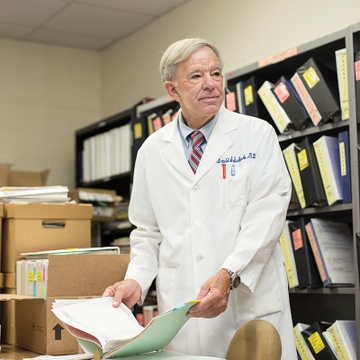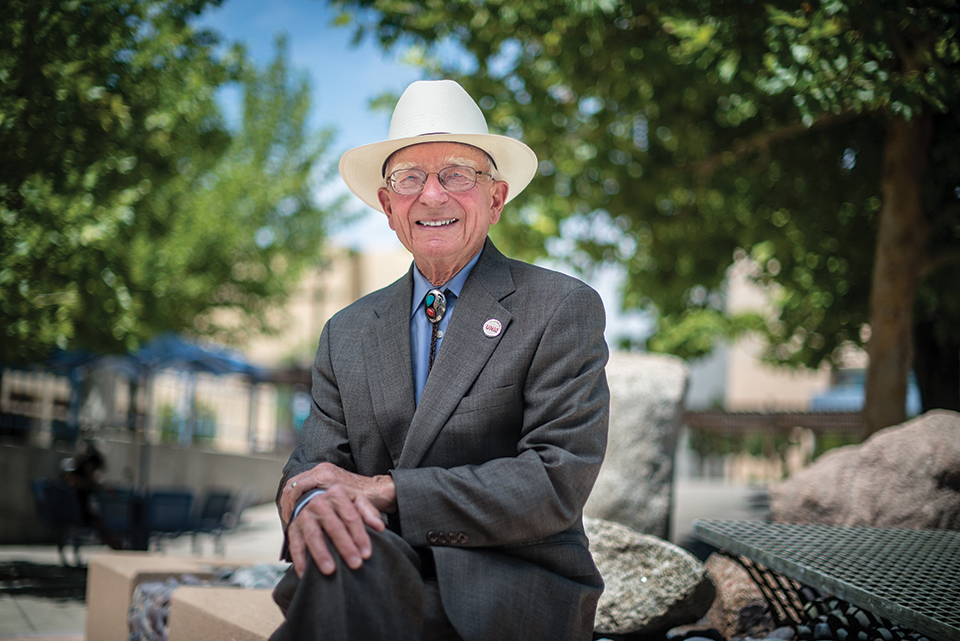Preparing for Disaster: UNM Hospital Participates in Region-Wide Emergency Training

Taking Matters to Heart
UNM Doctors Push to Expand Insurance Coverage for Coronary Artery Calcium Screening
Coronary artery calcium screening is a proven method for detecting cardiovascular disease before it has become clinically evident – giving patients and their health care providers a chance to dramatically reduce the future risk of heart attack or stroke.
Starting last January, major New Mexico health plans were required by state law to cover the cost of the test for most adults between the ages of 45 and 65.
But University of New Mexico School of Medicine physicians David S. Schade and R. Philip Eaton, who helped spearhead a successful effort in the Legislature to require insurance coverage for the screening, say it doesn’t go far enough to address the No. 1 cause of death in the state.
And they believe more needs to be done to educate doctors and the public about the screening’s benefits. “Cardiologists have not incorporated this test into routine management like we think they should be,” said Schade, chief of the Division of Endocrinology in UNM's Department of Internal Medicine.
The specialized CT scans, which take just 10 minutes to complete, identify deposits of calcium in the arteries that serve as markers for fatty cholesterol-laden plaques that can trigger a heart attack, he said.
A score of zero on the test means practically no artery disease is present and there is little likelihood of a heart attack in the next five years. A higher score signals the need for a simple drug regimen to reduce levels of low-density lipoprotein – LDL – the "bad" form of cholesterol that spurs the development of arterial plaques.

The scan is recommended for people who are identified by American Heart Association criteria as having an intermediate risk for having a heart event within 10 years
“The scan is recommended for people who are identified by American Heart Association criteria as having an intermediate risk for having a heart event within 10 years,” said Eaton, UNM’s emeritus executive vice president for Health Sciences.
“The incidence is roughly 20% of the adult population having this risk for cardiovascular disease identified by a health provider,” he said. “The scan basically separates who is at risk, and who actually has heart disease.”
Texas is the only other state that mandates insurance coverage for coronary artery calcium scans, Eaton said. While the scans are relatively inexpensive at $150, for many people paying out of pocket “there’s no question it’s a barrier,” Eaton said. “We can break down one of those barriers.”
Several years ago, Albuquerque cardiologist Barry Ramo co-authored a commentary published in the American Journal of Medicine with Schade, Eaton and UNM pediatrician S. Scott Obenshain, promoting expanded use of coronary artery calcium screening.
“In the last several years it has become very clear that this is one of the single most important predictors of subsequent coronary artery disease,” Ramo said. “But it has to be used in a careful manner. People who are at an intermediate risk are the ones who benefit the most.”
Ramo explains that the coronary calcium score means there’s a plaque in the artery that contains calcium. ‘The calcium itself is inert – it’s a marker,” he says. “If you have calcium it means you have coronary disease. It doesn’t mean you’re going to die right away. It should be a wakeup call.”
With that information doctors usually prescribe statin drugs that can significantly reduce LDL cholesterol levels and augment that with another drug called ezetimibe that lowers it even more, Ramo said.
“When you do that, there is mounting evidence if you can get the LDL cholesterol low enough it removes some of the fat from the plaques,” he said.
When the New Mexico Legislature passed House Bill 126 in 2020 it mandated that insurers pay for screening every five years for people between the ages of 45 and 65, provided they have a score of zero.
If the score is higher than that there is no further need to measure the calcium deposits in the artery wall because even with LDL-lowering therapy, it won’t go away. “It never causes any problems,” Schade explained. “Once it’s there, it’s there.”
As mandated by the law, large New Mexico health insurance plans started covering the procedure on January 31 of this year. The state Office of Superintendent of Insurance (OSI) will require smaller insurers to include the coverage starting in January 2022, Eaton said.
In the meantime, patients or physicians who believe their request for coverage has been erroneously denied should file a complaint with OSI, he said.
In their quest to expand coronary artery calcium screening, the pair know they still have work to do.
House Bill 126 only pertained to individual and work-related health insurance – 35 to 40% of New Mexico’s adult population, Eaton said. It doesn’t cover the 700,000 or so people who receive coverage through Medicaid, nor does it cover the 400,000 or so people on Medicare.
“We are following up on HB 126 to pursue coverage of those adults on Medicaid,” Eaton said. After that, he added, they will turn to Medicare. Prevention, he said, is a no-brainer.
“It is our perspective that neither the adult population nor the health professionals of the country realize this can be done now for a very reasonable cost and save huge amounts of the current cost of trying to save people who have a heart attack,” Eaton said.
“We want people to stop having heart attacks, and this can be done today.”